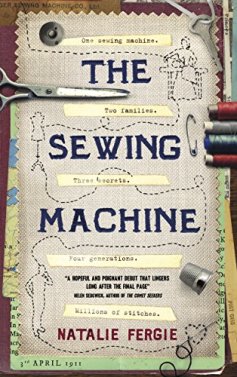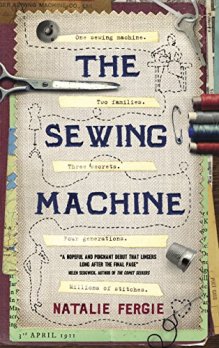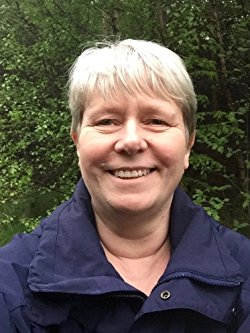
I have heard so many wonderful things about Natalie Fergie’s The Sewing Machine that, although I haven’t had chance to read it yet (it’s working its way up my TBR), I am thrilled to be able to interview Natalie on Linda’s Book Bag today.
The Sewing Machine was published by Unbound on 17th April 2017 and is available for purchase in e-book and paperback here.
The Sewing Machine

It is 1911, and Jean is about to join the mass strike at the Singer factory. For her, nothing will be the same again.
Decades later, in Edinburgh, Connie sews coded moments of her life into a notebook, as her mother did before her.
More than 100 years after his grandmother’s sewing machine was made, Fred discovers a treasure trove of documents. His family history is laid out before him in a patchwork of unfamiliar handwriting and colourful seams.
He starts to unpick the secrets of four generations, one stitch at a time.
An Interview With Natalie Fergie
Welcome to Linda’s Book Bag, Natalie. Thank you so much for agreeing to answer some questions on my blog about your writing and The Sewing Machine in particular. Firstly, please could you tell me a little about yourself?
Thank you for inviting me.
I live near Edinburgh, which is one of the locations for the novel. I left nursing in 2007 and began a small business dyeing yarn for knitters and fibre for spinners. I love colour, although most of the walls in our house are painted white.
What are your writing routines and where do you do most of your writing?
I would love to say I have a routine, but I don’t. Most of my writing is not done sitting at a computer, it’s done in my head when I am walking the dog, or sitting on a tram, or walking around Edinburgh. I work out the next part of what needs to happen and try it out. The dog is particularly helpful; he always listens and doesn’t mind if I say the same sentence twenty times in succession to get it right.
Without spoiling the plot, please could you tell us a bit about The Sewing Machine?
Sewing machines like the one in the book were workhorses used by our mothers and grandmothers as an essential piece of household equipment. They patched the knees of school trousers, made wedding dresses, and in war time, turned sheets sides-to-middle to make them last longer. The novel follows one such sewing machine, a handcrank Singer 99k, from the day it left the factory in 1911, until the present, in 2016.
The story begins with Jean, a worker in the Singer factory, who is about to go on strike. Her story alternates with that of the first owner, Kathleen, and in 2016 we meet Fred, who has just inherited the machine.
(I think it sounds wonderful – one of my earliest memories is of my grandmother using one of these machines.)
The Sewing Machine seems to me to be more than just a novel as fabric and textile is so big a part of your life. Why did you decide to write it?
The story really found me, rather than the other way around.
I collect old sewing machines. I have nine of them now, dating from 1897 until 1963. In the drawer of the oldest one was a Singer catalogue from 1929 and it seemed that after thirty years of using her old machine, the owner was looking for a replacement, just as we might today.
Old catalogues are like catnip to a collector – we instantly want to complete the set! It’s true whether we collect Pokemon cards, or stamps, or pencil sharpeners. I realised that there were many gaps in my collection and I set about looking for a 99K.
I researched the history of it first and discovered that it was first made in 1911, and if you google Singer factory 1911, you find the history of the strike at the factory.
The Sewing Machine is receiving glowing reviews from bloggers. How does that make you feel?
There aren’t enough words for this feeling. It’s lovely that so many people are enjoying it, and heartwarming to know that part of that is the story, but also that many people are loving the connection with their own family history because they remember similar sewing machines being used as they were growing up.
Every single review is like a little piece of treasure and I appreciate the time taken to write them. it’s such a kind thing to do, to tell an author that you like their work.
How important is it to you to ensure the heritage of textiles doesn’t die?
It was an integral part of life, for women (it was mostly women) to ‘Make Do and Mend’ during wartime and rationing. I feel these everyday items are just as important as fine 18th century gowns. It’s what they tell us about everyday life which fascinates me.
What advice would you give to those who would eschew an item like the sewing machine at the heart of your novel as being too old-fashioned and better thrown away?
Everyone has something old they are interested in. People save seed catalogues, or collect mugs or fridge magnets from holiday destinations.
We even keep books after we have read them, and store them on shelves!
And you only have to look at the popularity of car boot sales (like the one in the book) and Gumtree and eBay, to know that things which are old-fashioned are sought after. One woman’s discarded powder compact is another’s treasure.
How did you go about researching detail and ensuring The Sewing Machine was realistic?
I used the internet, and saved useful sites in Evernote so I could find them again. I kept the plot order in an old Filofax, because it meant that I could shuffle things around and flip through to make sure everything still worked.
There was an awful lot of arithmetic, to make sure that people weren’t still at school at twenty-five, or retiring at the wrong age, and I used weather records for all the different eras to find out whether it was hot or cold or snowing on a particular week.
I went to a wonderful museum in Edinburgh which is a reminiscence centre; you can pick up all the items and look at them closely – wind up a lipstick, sniff a tin of baby talc or look at things like grocer’s paper bags. That was where I discovered that Alf’s Thermos flask had a cork and not a screw top!
But the best research was done by talking to people in organisations. I spoke to the Royal Botanic gardens in Edinburgh about how to store seeds, to a jeweller about enamelling and to a housing organisation about tenants’ rights. Without fail, everyone was generous and they gave me insight I could not have got from a website.
(That sounds so interesting to do Natalie.)
Bearing all that research in mind, which aspects of your writing do you find easiest and most difficult?
I love the research and do ten times the amount which actually ends up in the book.
The hardest part is knowing when to stop editing. If you do too much, you take the energy out of the words and leave them dried up and lifeless on the page.
When you’re not writing, what do you like to read?
Magazines!
There is something about a new magazine, all those untouched pages and bright colours and ideas in short snatches. It’s like a tasting menu in a posh restaurant.
For books, I’ll read most things except horror, and that’s true of cinema too. I don’t like to be terrified, I guess I’m just a scaredy cat. I’m currently reading the debut novel, Wages of Sin, by Kaite Welsh, about a Victorian lady doctor-turned-detective.
(I have that on my TBR too!)
The Sewing Machine has a cover that reminded me of the Fates. How did that image come about and what were you hoping to convey (without spoiling the plot please!)?
The cover was designed by Mark Ecob.
Unbound is unusual in involving the authors closely in the cover design. I’m told that generally in publishing, this isn’t the case.
I sent him an idea which was based on the idea of an Instagram image, where there are objects from the book arranged around the edges of a cover. He took that idea and created the cover. If you look closely after you have finished reading, you’ll discover that all the snippets of paper, the maps, the thread, everything appears in the novel. You can’t work the story out from looking at them though…
If you had 15 words to persuade a reader that The Sewing Machine should be their next read, what would you say?
“Did your grandmother sew? Unpick the secrets of four generations, one stitch at a time.”
Thank you so much for your time in answering my questions Natalie. I can’t wait to read The Sewing Machine.
About Natalie Fergie

As well as loving writing, Natalie Fergie dyes and cooks and spends time walking Boris the dog!
You can find out more about Natalie on her blog, by following her on Twitter @theyarnyard and visiting her Instagram page.

I loved this interview and I loved the book.
LikeLiked by 1 person
So pleased you enjoyed the interview. I’ve still to read the book but I can’t wait as it sounds wonderful.
LikeLike
This is a great interview. My sister sews for a living, and I sew for myself. I can’t wait to get this unique book. Thanks!
LikeLiked by 1 person
Thanks so much for calling by – I’m so glad you enjoyed it.
LikeLike
Great interview Linda, and the book was wonderful!
LikeLiked by 1 person
I have it on my huge TBR Jo!
LikeLike
There times when you read a book, you want to meet the characters. I want to meet Mrs Fergie. Thank you for the interview.
LikeLiked by 1 person
Thanks for dropping by and commenting Diane.
LikeLike
I would like to purchase a hardcover copy. I only see access to paperback.
Thank you!
LikeLiked by 1 person
I think it is not available in hardback sadly Donna.
LikeLike